2009 AUDI S4 CABRIOLET height
[x] Cancel search: heightPage 94 of 340

Seats and storage
Seats and storage
General recommendations
Why is your seat adjustment so important?
The safety belts and the airbag system can only provide
ma ximum protection if the front
seats are correctly
a djusted.
There are var ious ways of adjusting the front seats to provide safe
and c omfortable support for the driver and the front passenger.
Adjust your seat properly so that:
• you can easily and quickly reach all the switches and controls in
the instrumen t pa nel
• your body is proper ly supported to reduce physical stress and
f atigue
• the safety belts and airbag system can offe r maximum protec
tion=>
page 768.
I n the fo llowing chapters, you wil l see exact ly how you can best
adjust your seats.
There are special regulations and instructions for instal ling a child
safety seat on the front passenger seat. A lways heed the informa
tion regarding child safety provided in=>
page 790, "Child Safety".
& WARNING
Inco rrect se ating po sition of the driver a nd all other pa ssengers
c an result in serious per sonal injury.
• Alway s keep your feet on the floo r when the vehi cle is in motion
- never put your feet on top of the in strument panel , out of the
window o r on top of the seat cushio n! This appl ies espe ciall y to
the pa ssenger s. If your seating position i s incorre ct you increase
the ri sk of inju ry in the c ase of sudden br aking or an accident .
If
& WARNIN G (continued )
the airb ag inflate s and the seating position is incorre ct thi s could
r e sult in per sonal injury or even death.
• It is important for both the driver and front p assenger to keep
a distan ce of at least 10 inche s (25 cm) betw een them se lve s and
the steering wheel and /or in strument p anel . If you are sitting any
closer than this , the airbag system cannot protect you properly . In
a ddition to this , the front se ats and head re str aints mu st be
adjusted to your body height so th at they can give you maximum
protection .
• Alway s try to keep as much distan ce as possible between your
s elf and the steerin g wheel or in strument p anel.
• Do not adjust the driver's or front pas senger seat while the
vehicle is mov ing . You r seat may mo ve unexpect edly , ca usin g
s udden los s of vehicle control and per sonal injury.
If you adjust
your seat while the vehi cle i s moving , you a re out of position .
0 Note
When the front seats are in the reclined position, make certain that
the seatbacks are not pushed against the built -in air deflector *
when you run the sea ts back toward the rear of the vehicle and
when you lower the seatback. This can damage the air deflector and
the latching mecha nis m. •
Driver seat
The correct seat position is importan t for safe and relaxed
drivin g.
We recomme nd tha t yo u adjust the dr iv e r's sea t in the
fol lowing ma nne r:
Page 95 of 340

- Adjust the seat in fore and aft direction so that you can
easily push the pedals to the floor while keeping your
knee slightly bent==>
& in "Why is your seat adjustment
so important?".
- Adjust the seatback so that when you sit with your back against the seatback, you can still grasp the top of the
steering wheel.
- Position the head restraints according to the occupant's
height. For maximum protection, the upper edge of the
head restraints should be at least at eye level, or higher
==>
page 757,fig.156.
& WARNING
Never place any objects in the driver's footwell. An object could
get into the pedal area and interfere with pedal function. In case
of sudden braking or an accident, you would not be able to brake
or accelerate! •
Front passenger seat
Always move the front passenger seat into the rearmost
position.
To avoid contact with the airbag while it is deploying, do not
sit any closer to the instrument panel than necessary and
always wear the three-point safety belt provided adjusted
correctly. We recommend that you adjust the passenger's
seat in the following manner:
- Move the front passenger seat into the rearmost position
of the fore and aft adjustment range ==>
& in "W hy is
your seat adjustment so important?" on
page 92.
Controls and eq uip
ment
Seats and storage
- Bring the backrest up to an (almost) upright position . Do
not ride with the seat reclined.
- The ideal position for the head restra int is with the upper
edge of the restraint level with the top of your head
==>
page 95 and ==> page 98. You should not lower the top
of the rest ra int below the level of your eyes.
- Place your feet on the floor in front of the passenger's
seat. •
Manual seats
Applies to veh ic les: with manua lly adjustab le seats
Adjustment controls
Various controls on the manual seats provide a wide
range for individual adjustments.
0 Moving the seat forward or backward
0 Extending the seat cushion
© Adjusting the seat cushion angle
© Adjusting the seat height
© Adjusting the lumbar support*~ page 98
Fig. 104 Adjustment
controls: locations on
driver seat
© Adjusting the seatback angle .,
~ehicle care irechnical data
Page 96 of 340
![AUDI S4 CABRIOLET 2009 Owners Manual Seats and storage
[ i] Tips
Some of the controls are fitted on certain model s only or they are
opt ional equipment. •
Applies to vehic les: w ith man ually adjustab le sea ts AUDI S4 CABRIOLET 2009 Owners Manual Seats and storage
[ i] Tips
Some of the controls are fitted on certain model s only or they are
opt ional equipment. •
Applies to vehic les: w ith man ually adjustab le sea ts](/manual-img/6/57654/w960_57654-95.png)
Seats and storage
[ i] Tips
Some of the controls are fitted on certain model s only or they are
opt ional equipment. •
Applies to vehic les: w ith man ually adjustab le sea ts
Adjusting the manual seats
Position, angle and shape of the manual seats can be
adjusted to provide safe and comfortable seating.
Reed and heed all WARNINGS ~ & before you adjust your
seat.
Moving the seat forward or backward
Lift lever G) ~ page 93, fig. 104 and slide the seat to the
desired position.
- Release the lever
(D and then move the seat further until
you feel and hear it engage .
Extending/shortening the seat cushion*
-Grab the handle just below the front edge of the seat®
~ page 93 , fig. 104.
- Slide the seat cushion extens ion backward or forward to
the desired position. Release the handle to lock the
extension in place.
Adjusting the seat cushion angle
- Pull the lever 0 ~ page 93, fig. 104 up and pump it to
raise the front of the seat cushion.
- Push the lever
0 down and pump it to lower the front of
the seat cushion. -
In either case, shift your weight in the direction you want
the seat to tilt to support the adjustment action.
Adjusting the seat height
- Pull the lever © up and pump it to raise the seat .
- Push the lever © down and pump it to lower the seat.
Adjusting the lumbar support
-Press the corresponding depression on the switch shell
© to adjust the height and contour of the lumbar
support, see~ page 98.
Adjusting the seatback angle
- Lean forward to take your weight off the seatback.
- Turn the hand wheel © in the direction you want the
seatback to ti It.
& WARNING
• Never adjust the driver or front passenger seat while the
vehicle is moving. If you do this while the vehicle is moving, you
will be out of position. Always adjust the driver's or front
passenger seat when the vehicle is not moving.
• Be careful when adjusting the seat height. Check to see that no
one is in the way, or serious injury could result!
• To reduce the risk of injury in the case of sudden braking or
accident, front passengers must never ride in a moving vehicle
with the seatback reclined. Safety belts and the airbag system
only offer maximum protection when the seatback is upright and
the safety belts are properly positioned on the body. The more the
seatback is reclined, the greater the risk of personal injury from an
incorrect seating position and improperly positioned safety
belts! •
Page 97 of 340
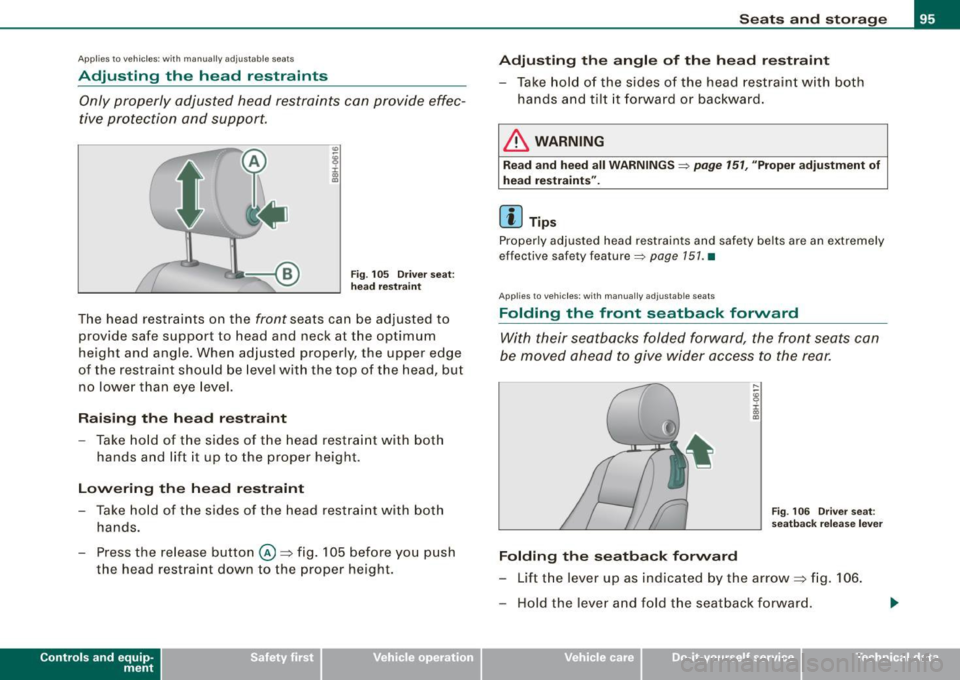
Applies to vehic les: with manua lly adjustab le seats
Adjusting the head restraints
Only properly adjusted head restraints can provide effec
tive protection and support.
Fig . 105 Driver seat:
head restraint
The head restraints on the front seats can be adjusted to
provide safe support to head and neck at the optimum
height and angle . When adjusted properly, the upper edge
of the restraint should be level with the top of the head, but
no lower than eye level.
Raising the head restraint
-Take hold of the sides of the head restraint with both
hands and lift it up to the proper height.
Lowering the head restraint
- Take hold of the sides of the head restraint with both
hands.
- Press the release button @=>fig. 105 before you push
the head restraint down to the proper height.
Controls and eq uip
ment
Seats and storage
Adjusting the angle of the head restraint
- Take hold of the sides of the head restraint with both
hands and tilt it forward or backward.
& WARNING
Read and heed all WARNINGS => page 151, "Proper adjustment of
head restraints".
[ i] Tips
Properly adjusted head restraints and safety belts are an extremely
effective safety feature=>
page 151. •
App lies to veh ic le s: with manua lly adjustab le sea ts
Folding the front seatback forward
With their seatbacks folded forward, the front seats can
be moved ahead to give wider access to the rear.
Folding the seatback forward
Fig . 106 Driver seat:
seatback release lever
-Lift the lever up as indicated by the arrow => fig. 106.
- Hold the lever and fold the seatback forward.
~ehicle care irechnical data
Page 98 of 340
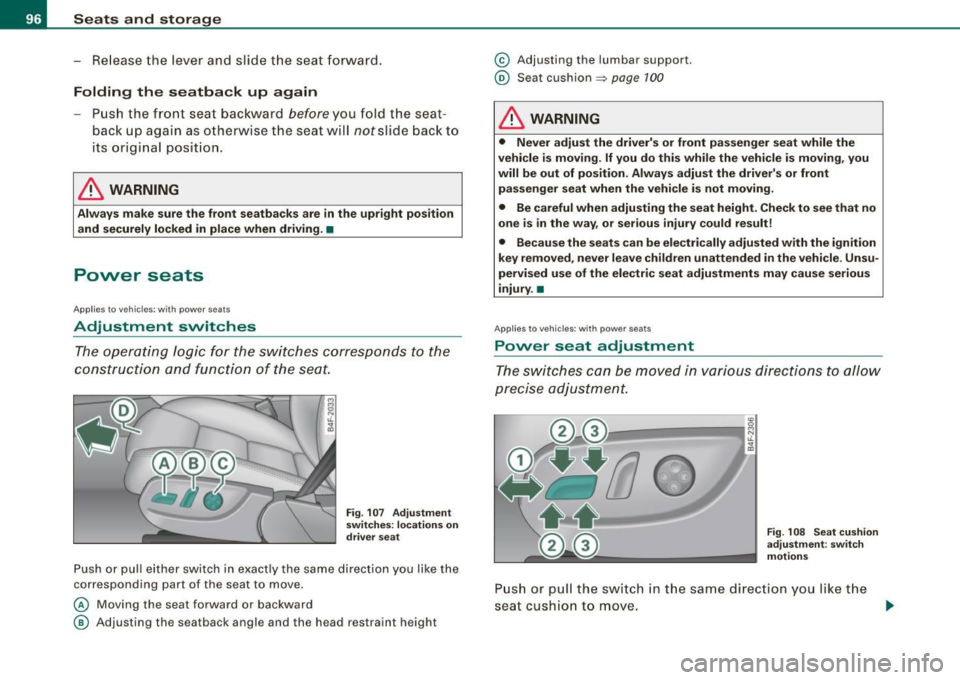
Seats and storage
- Release the l ever an d s lide th e se at fo rwar d.
Folding the seatback up again
Pu sh the front seat bac kward befo re y ou fol d the se at
b ac k up ag ain as o the rwise t he seat will
not slide bac k to
its origin al po sit io n .
& WARNING
Always make sure the front seatbacks are in the upright position
and securely locked in place when driving. •
Power seats
Applies to vehic les : wi th p ow er sea ts
Adjustment switches
Th e operati ng logic f or t he swit ches c orresp on ds to the
co nstru ction and functio n of th e seat.
Fig . 10 7 Adjustment
switches: locations on
driver seat
P ush o r pull ei ther swi tc h in ex actly the sa me di re ct io n yo u like th e
corresponding part of the seat to move.
© Moving the seat forward or bac kward
@ A djusting the seatback ang le and the head restraint height
© A djusting the lumbar s upport.
© Seat cushion => page 1 00
& WARNING
• Never adjust the driver's or front passenger seat while the
vehicle is moving. If you do this while the vehicle is moving , you
will be out of position . Always adjust the driver's or front
passenger seat when the vehicle is not moving.
• Be careful when adjusting the seat height . Check to see that no
one is in the way, or serious injury could result!
• Because the seats can be electrically adjusted with the ignition
key removed , never leave children unattended in the vehicle . Unsu
pervised use of the electric seat adjustments may cause serious
injury. •
Applies to veh ic les : w ith p ower sea ts
Power s eat adjustment
The sw itches can be move d in v ari ous dir ec tio ns to allow
p recise adj ustmen t.
Fig . 10 8 Seat cushion
adjustment : sw itch
motions
P u sh or p ull the s witch in t he sa me dir ec tio n you like t he
se at c ushio n to m ov e . ._
Page 99 of 340
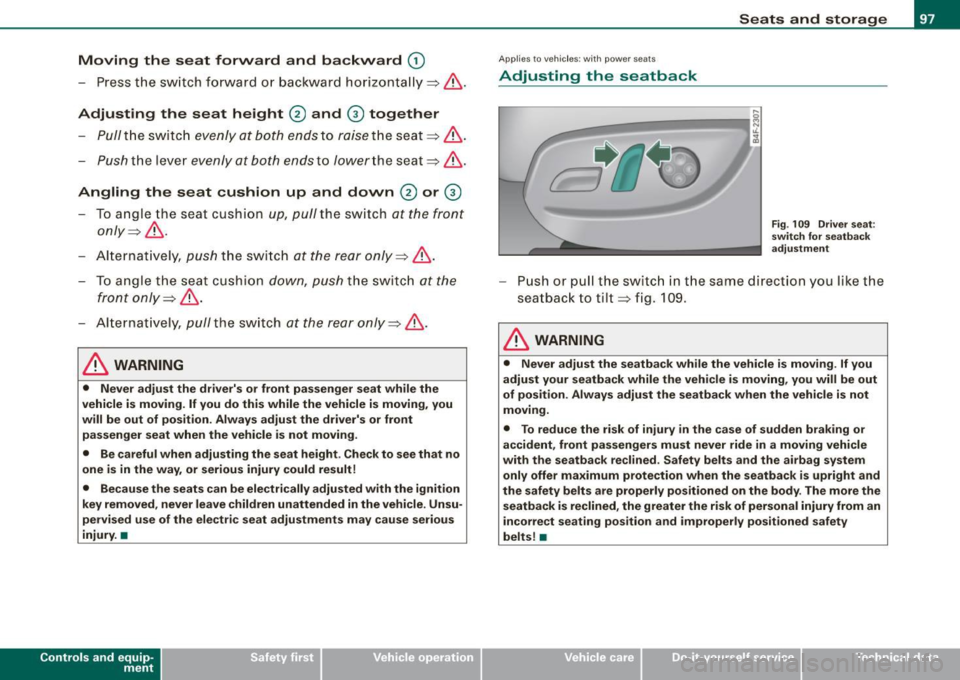
Moving the seat forward and backward (D
-Press t he swi tch fo rward or back ward h orizon ta lly => & -
Adjusting the seat height @ and 0 together
Pull the sw it c h eve nly at b oth ends to r aise th e sea t=> & .
-Pus h th e le ver e venl y at both ends to lo we r the seat =>& .
Angling the seat cushion up and down @ or 0
To an gle th e se at cush ion up, pull th e swit ch at t he front
on ly=>
&-
- Alter nativel y, push the sw it c h at the re ar onl y=> & .
- To ang le the seat cush io n down, pu sh the switch at th e
fron t o nly =>
&-
- Alt e rn ativ ely, p ull the switch at the r ea r only =>& .
& WARNING
• Never adjust the driver's or front passenger seat while the
vehicle is moving . If you do this while the vehicle is moving , you
will be out of position . Always adjust the driver's or front
passenger seat when the vehicle is not moving.
• Be careful when adjusting the seat height . Check to see that no
one is in the way, or serious injury could result!
• Because the seats can be electrically adjusted with the ignition
key removed , never leave children unattended in the vehicle. Unsu
pervised use of the electric seat adjustments may cause serious
injury. •
Contro ls and eq uip
ment
Ap plies to veh ic les : w ith powe r seats
Adjusting the seatback
Seats and storage
Fig . 109 Driver seat :
sw itch for seatback
adjustment
Push or pull th e swit ch in th e sa me dir ectio n y ou lik e the
s eat back t o tilt => fig. 1 09.
& WARNING
• Never adjust the seatback while the vehicle is moving . If you
adjust your seatback while the vehicle is moving, you will be out
of position . Always adjust the seatback when the vehicle is not
moving.
• To reduce the risk of injury in the case of sudden braking or
accident, front passengers must never ride in a moving vehicle
with the seatback reclined . Safety belts and the airbag system
only offer maximum protection when the seatback is upright and
the safety belts are properly positioned on the body . The more the
seatback is reclined , the greater the risk of personal injury from an
incorrect seating position and improperly positioned safety
belts !•
~ehicle care irechnical data
Page 100 of 340
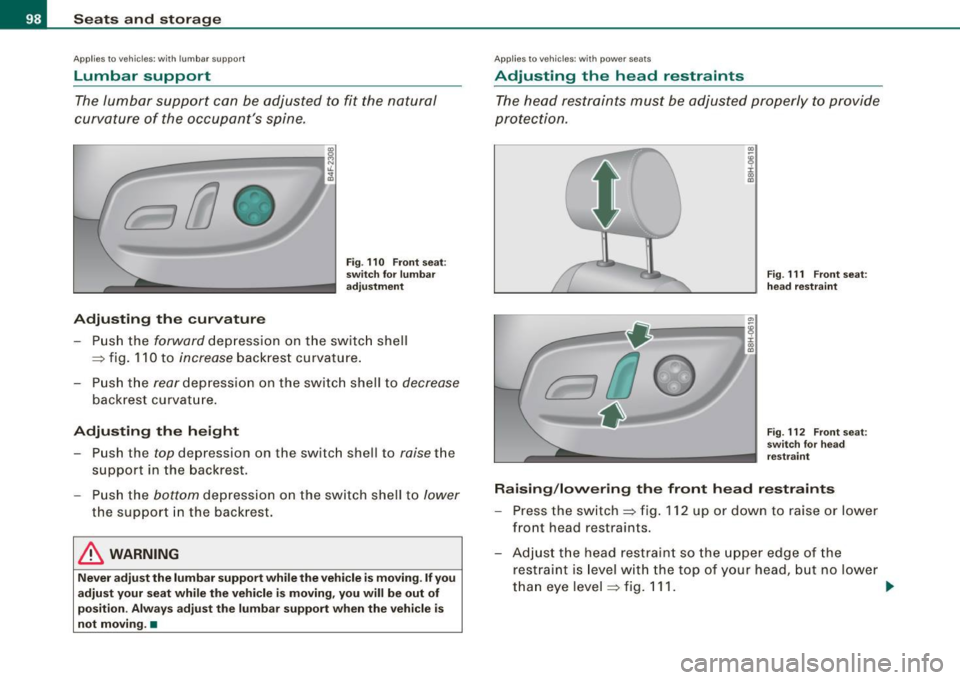
Seats and storage
Applies to veh ic les: with lumbar support
Lumbar support
The lumbar support can be adjusted to fit the natural
curvature of the occupant's spine.
Adjusting the curvature
Fig . 110 Front seat:
switch for lumbar
adjustment
- Push the forward depress ion on the switch shell
=:> fig. 110 to increase backrest curvature.
- Push the
rear depression on the switch shell to decrease
backrest curvature.
Adjusting the height Push the
top depression on the switch shell to raise t he
support in the backrest.
- Push the
bottom depression on the switch shell to lower
the support in the backrest.
in. WARNING
Never adjust the lumbar support while the vehicle is moving. If you
adjust your seat while the vehicle is moving, you will be out of
position. Always adjust the lumbar support when the vehicle is
not moving. •
Applies to vehic les : w ith power seats
Adjusting the head restraints
The head restraints must be adjusted properly to provide
protection.
..
Fig . 111 Front seat:
head restraint
Fig . 112 Front seat:
switch for head
restraint
Raising/lowering the front head restraints
- Press the switch
=:> fig. 112 up or down to raise or lower
front head restraints.
- Adjust the head restraint so the upper edge of the
restraint is level with the top of your head, but no lower
than eye level
=:> fig. 111. _.,
Page 101 of 340
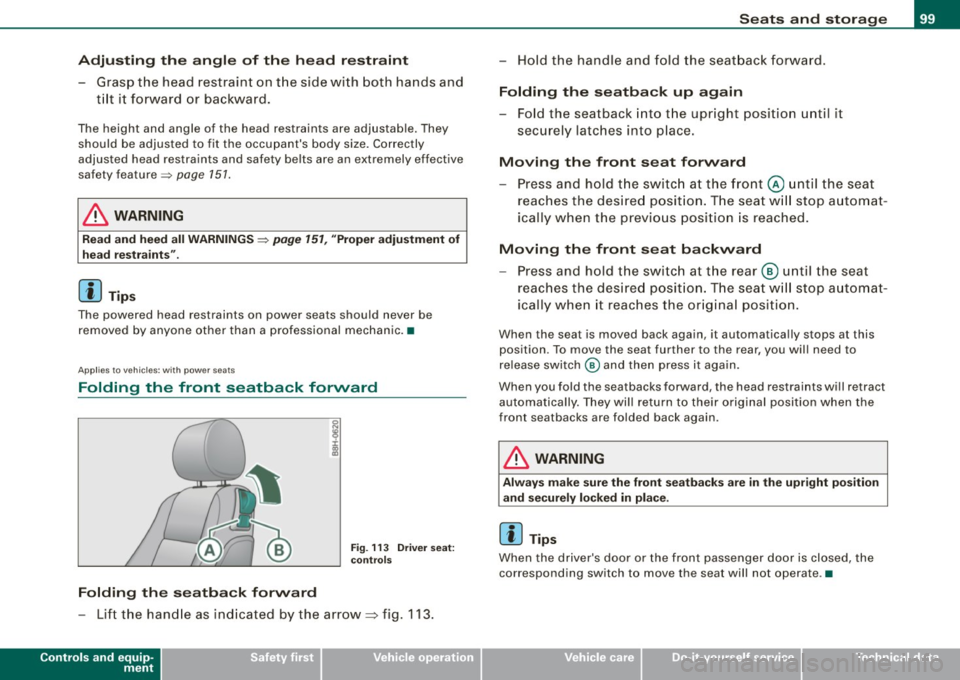
Adjusting the angle of the head restraint
-Grasp the head restraint on t he side with both hands and
t il t it forward or backward.
The height and angle of the head restraints are adjustable. They
should be adjusted to f it the occ upan t's body size. Correc tly
adjusted head restraints and safety be lts are an extremely effective
safety feature ~
page 151.
& WARNING
Read and heed all WARNINGS~ page 151, "Proper ad justment of
head restraint s".
[ i ] Tips
The powered head restraints on power seats should never be
removed by anyone other than a p rofessional mechanic. •
Applies t o vehicles: with power seats
Folding the front seatback forward
Folding the seatba ck forward
Fig . 11 3 Driv er seat :
co ntr ols
- Lift t he hand le as ind icated by the arrow~ fig. 113.
Controls and equip
ment
S eats and storage
- Ho ld the handle and fold t he seat back fo rwa rd .
Folding the seatback up again
- Fo ld the seatback into t he upr ight position until it
securely latches into place.
Moving the front seat forward
- Press and h old t he swi tc h at th e fr ont @ un til th e sea t
reach es the des ire d posit ion. T he s eat w ill stop a uto mat
ically when the previo us position is reached.
Moving the front seat backward
- Press and hold t he swi tc h at t he rear ® until the se at
reaches the des ire d posit ion . Th e seat w ill stop a utomat
icall y whe n it reac hes the or ig ina l posi tion .
When the seat is moved back again, it automatica lly stops at this
position. To move the seat further to the rear, you wil l need to
re lease switch @ and then press it again.
When you fold the seatbacks forward, the head restraints will retract
automatica lly. They will return to their o riginal positio n when the
front seatbacks are folded back again.
& WARNING
Always make sure the front se atbacks are in the upright po sition
and securely locked in place .
[ i ] Tips
When the driver's door or the fr ont passenger door is closed, the
corresponding switch to move the seat will not operate .•